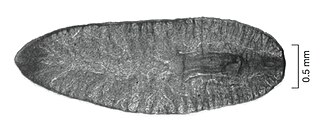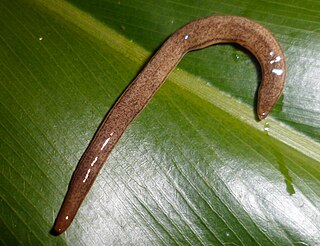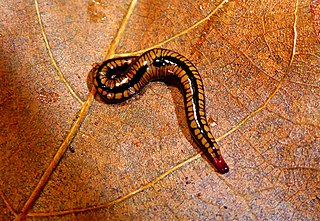
A planarian is one of many flatworms of the traditional class Turbellaria. It usually describes free-living flatworms of the order Tricladida (triclads), although this common name is also used for a wide number of free-living platyhelminthes. Planaria are common to many parts of the world, living in both saltwater and freshwater ponds and rivers. Some species are terrestrial and are found under logs, in or on the soil, and on plants in humid areas.

Dugesia is a genus of dugesiid triclads that contains some common representatives of the class Turbellaria. These common flatworms are found in freshwater habitats of Africa, Europe, Middle East, Asia, and Australia. Dugesia is best known to non-specialists because of its regeneration capacities.
Edgbastonia coreena is a species of small freshwater snails which have an operculum, aquatic gastropod mollusks in the family Tateidae.

Geoplanidae is a family of flatworms known commonly as land planarians or land flatworms.

Dugesiidae is a family of freshwater planarians distributed worldwide. The type genus is Dugesia Girard, 1850.

Girardia is a genus of freshwater planarians belonging to the family Dugesiidae.
Dugesia notogaea is a species of dugesiid triclad that inhabits freshwater bodies of north Queensland, Australia.
Dugesia tubqalis is a species of dugesiid triclad that inhabits springs of Morocco, Africa. It's named after the Toubkal peak, the highest in the Atlas Mountains. It has been found between 1,702 and 2,164 m of altitude.
Dugesia sicula is a species of dugesiid triclad that lives in freshwater bodies of the Mediterranean Basin, where it is widely distributed. It has been reported from Sicily, Elba and Mallorca, Eivissa, Sardinia, Algeria, Tunisia, Morocco and Crete.
Girardia tigrina is a species of dugesiid native to the Americas. It has been accidentally introduced into Europe and Japan.

Weissius capaciductus is a species of dugesiid triclad that inhabits in Australia.

Dimarcusidae is a family of triclads found mostly in freshwater habitats of caves, although at least one species, Rhodax evelinae, occurs in surface waters. It is the only family within the suborder Cavernicola. Currently the family contains only seven species distributed in five genera, although the total number of species is thought to be much higher.

The reproductive system of planarians is broadly similar among different families, although the associated structures can vary in complexity.

Luteostriata abundans is a species of Brazilian land planarian in the subfamily Geoplaninae. It is a common species in human-disturbed areas in Brazil's southernmost state, Rio Grande do Sul.

Obama josefi is a species of Brazilian land planarian in the subfamily Geoplaninae.

Supramontana irritata is a species of Brazilian land planarian in the subfamily Geoplaninae. It is the type species of the genus Supramontana.

Marionfyfea is a genus of land planarians from Antarctic Islands off New Zealand. However, a species has been described from specimens found in Europe, probably introduced.

Marionfyfea adventor is a species of land planarian described in 2016 from specimens found in the United Kingdom, the Netherlands and France. However, since the species belongs to the genus Marionfyfea, of which the species are known only from subantarctic islands off New Zealand, it is probably an introduced species in Europe.

Othelosoma is a genus of land planarians found in Africa and India.

Bothrioplana is a genus of freshwater flatworms, the sole genus in the family Bothrioplanidae and order Bothrioplanida.














